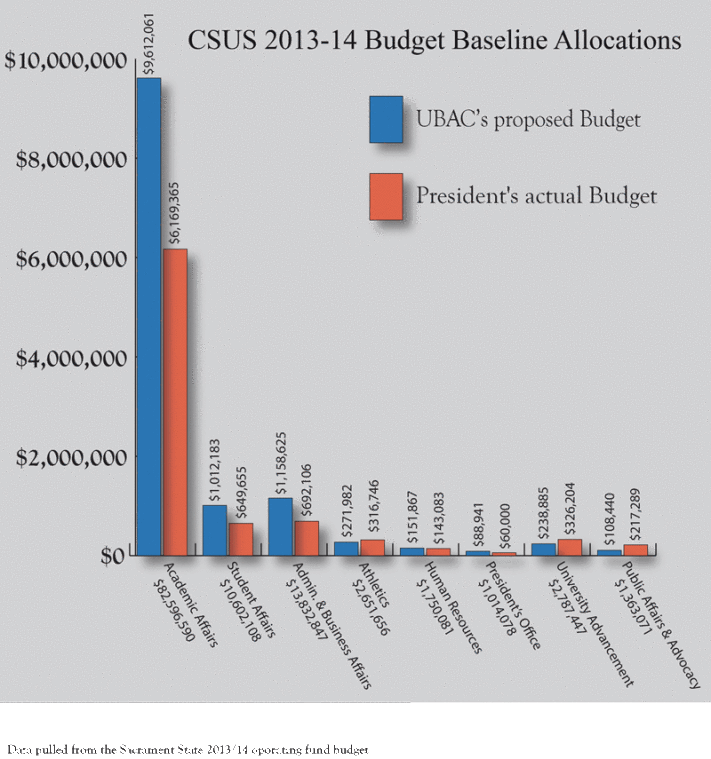Sacramento State’s new budget raises concerns over prioritization, faculty hiring
September 11, 2013
The slight discrepancy between the faculty-recommended budget proposal in March and the budget approved by Sacramento State President Alexander Gonzalez in May, has some people raising questions regarding budget prioritization, faculty hiring and student success.
While Gonzalez approved an 8 percent baseline increase for Academic Affairs and Student Affairs – an action consistent with the University Budget Advisory Committee’s recommendation – he did not approve an additional one-time allocation to every division as recommended.
Instead, Gonzalez used the one-time allocations as additional baseline funding in other smaller divisions – including Public Affairs and Advocacy, University Advancement and Athletics.
“He left the (University Budget Advisory Committee) recommendation on the mission critical part alone and took what, in my estimation, are the other things that are not as mission critical and increased all of those,” said University Budget Advisory Committee member Christine Miller.
Gonzalez said he allocated more to Public Affairs this year to further emphasize marketing and communications, as well as University Advancement to aid in fundraising.
Public Affairs received the largest baseline increase at 19 percent, or an additional $217,289 compared to the 2012-2013 budget.
In contrast, Academic Affairs received $6.1 million and Student Affairs received $649,655 compared to the 2012-2013 budget.
“After thoughtful consideration and analysis, I have also augmented baseline funding for the other divisions on campus, particularly those that are smaller and therefore have been affected in greater severity by previous budget cuts,” Gonzalez said in his budget memo to the campus community.
Miller said while each division has an important place in serving the mission of the university, some are not doing the same direct work as Academic and Student Affairs in achieving student access.
“If someone can show me how (Public Affairs) graduates students I would love to hear it,” Miller said. “I know what they do. But they are not responsible for students getting diplomas in their hands. Academic and Student Affairs do that.”
University Budget Advisory Committee members are chosen from a list of faculty by the president and serve three-year terms, beginning with the academic year.
The committee starts meeting around November as revenue projections become available, and will meet with each vice president of the corresponding division to compile a recommended budget.
“In the end I make the decision, but it really is a very community type of activity,” Gonzalez said. “Everybody gets in it. Everything is open.”
Gonzalez said he typically approves the recommendation he is presented, but once in awhile he will tweak the numbers depending on the university’s plan and vision.
“In his mind, (Gonzalez) is thinking that we will grow but we have to be very careful,” said Vice President and Chief Financial Officer Mike Lee. “No. 1, we have to have a plan to get there. No. 2, it has to be strategic. We cannot just be restoring whatever we have lost in the past few years.”
Lee said the University Budget Advisory Committee is an advisory board that makes recommendations and while Student and Academic Affairs are important, Sac State also needs to increase funding for other divisions so it can properly support the university as a whole.
“The way he did it was not by taking away what (the University Budget Advisory Committee) recommended for those two divisions,” Lee said. “(He did it) by dipping into the portion that was already reserved and putting it in other divisions.”
University Budget Advisory Committee member Scott Farrand said he is concerned about the number of faculty members hired under the new budget and is hopeful a vigorous hiring process will occur next year.
“It’s a very important issue for the university now because so many departments are in dire straits without more faculty,” Farrand said. “(The University Budget Advisory Committee) structured its recommendations around faculty hiring and I don’t think nearly enough is going on.”
Cal State Fullerton recently hired 33 new tenure-track faculty members to serve approximately 37,000 students. Sac State hired 25 new tenure-track faculty members to serve approximately 28,000 students.
Fullerton President Mildred García announced last month the school will be conducting a search to hire 133 tenure-track faculty members over the next two years.
Farrand said he is unaware how many new faculty searches will be underway for fall 2014 and is concerned retirements will leave departments with insufficient full-time faculty.
“(The University Budget Advisory Committee) signaled to the president that we believe resources need to go towards enhancing the mission of student success via for example, faculty hiring,” Miller said.
Lee said students also benefit from Sac State maintaining friendships within the community because it can create donors for future projects. He said the majority of the money the campus raises goes towards student scholarships.
“The other part (Gonzalez) is putting emphasis on is Public Affairs and Advocacy,” Lee said. “This is really to take what Sac State has been doing and doing a good job and share it with the community, let people know.”
Farrand said he is reluctant to be critical of the budget because Gonzalez may be in possession of more information and must be mindful of other things.
Both Farrand and Miller said around the time the University Budget Advisory Committee presented its recommendation to Gonzalez in March, the committee learned approximately an additional $1 million became available to the university due to unexpected revenue growth. The committee did not adjust its recommendations due to the timeliness of the deadline.
“We make recommendations,” Farrand said. “(The president) makes decisions.”










































































































































